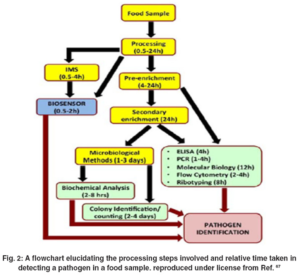New leaps in biosensing
The field of biosensors has certainly witnessed astonishing growth in recent times. Over the last three decades, the number of papers published on the subject each year has increased/risen approximately 4000%. Biosensor development and construction has focused predominantly on clinical research, continuing on the pioneering efforts of Clarke in 1950’s and 60’s. Yet, a shift in biosensor focus towards food analysis has grown in the last decade due to the improved accuracy in target pursuit, intensifying demands about quality from stakeholders, such as safety regulators, traders and consumers as well as significant reduction in analysis times associated with electrochemical detection.
In the agriculture and food industries, early detection and sensitive analysis of potential contaminants and toxins is crucial and driven by a multiplicity of factors, such as the short shelf life of many fresh food products, increasing consumer preferences for chemical free and unprocessed foods, minimization of waste/reduction of costs in processing operations, and the need for detection in very low quantities, and removal of pathogens from the supply chain that may cause serious illness to the consumer.
These pressures are exacerbated by the inherent limitations of traditional food analysis methods that involve expensive, cumbersome instrumentation and as a result, have helped shape biosensor development relating to food analysis. Naturally, researchers have recognized the need for inexpensive, portable sensors that can perform rapidly and accurately with great sensitivity.
Food analysis challenges
Biosensors address three broad categories of food analysis expectations: safety, quality and authenticity. Food safety screening focuses on the detection of undesirable contaminants in food, such as pesticide and antibiotic residues, allergens, biological toxins and pathogenic microbes. Similar analysis is also used to establish or confirm the nutritional value of a food product. Authenticity analysis seeks to confirm the origin and/or production process of a food stuff, while also providing information about the adulteration or counterfeiting of food. The literature indicates that presently, electrochemical biosensors are primarily being utilized in food safety rather than quality and authenticity analysis.
Traditional analysis methods for detecting harmful microorganisms, such as pathogenic Escherichia and Salmonella, aflatoxins and pesticides such as organophosphates and carbamates could only be conducted post-production. This limitation is easily overcome by the use of biosensors which allows food items to be tested at all phases of production from raw materials screening to the product on shelf, resulting in more efficient means of ensuring of food safety and outbreak prevention.
Timeliness and costs
Improved analysis times is another benefit to biosensor application in food analysis. Using an array of biosensors on a microfluidic or lab-on-a-chip platform, low volume samples can be analyzed directly, thus eliminating the need for laborious and costly sample preparation stages. This is a particularly attractive feature of biosensors, where toxin accumulation often correlates with time, for example, mycotoxins are harmful carcinogenic metabolites produced by mold which affects many food products, including but not limited to; bread, cereals, dried fruit, wine and meat products.
Biosensors present an attractive alternative as their capability of being used in situ allows reduced detection times, from several days to hours, or even minutes as illustrated in Figure 2. Other advantages stemming from in-situ determination capabilities include minimized sampling protocols, reduced storage requirements and the removal of often elaborate sample preparation procedures. Furthermore, in-situ detection capabilities allow for the improved portability of analysis tools such as handheld detection devices which generally require minimal training to operate and can facilitate the integration of real time analysis in food processing work centers/systems. Improved timeliness within food processing systems can also reduce spoilage, particularly in fresh produce, such as seafood, this was illustrated by the development of for the rapid detection of Vibrio parahaemolyticus – a leading global cause of bacterial gastroenteritis. Whilst bacteriophages have been successfully used to remove antibiotic strains of V. parahaemolyticus from seafood, the method lengthens the time between catch and plate, thus reducing the seafood’s freshness and ultimately

The cost effectiveness of biosensors cannot be overstated. The rapid analysis rendered from biosensing allows significant gains through cost mitigation normally reserved for sample preparation methods and the need for expensive laboratories with highly trained staff, and the additional possibility of automated on-line analysis in food processing plants which will further reduce cost. Moreover, the ability of biosensors to detect contaminants in raw foods in real-time with high specificity and very low concentrations reduces waste and the economic costs associated with health issues and product recalls.
Losses due to sample preparation
A fundamental prerequisite to using traditional methodologies in food analysis is the sample homogenization process, which can be problematic because of the organic acids and antimicrobial compounds present in many fruits and vegetables. The release of these compounds during sample preparation can inhibit the detection of certain contaminants, potentially having detrimental impacts on product consumers, a problem not encountered by biosensors as they require little or no sample preparation. Methods commonly used for detecting pathogenic bacteria detection in foods, such as enzyme-linked immunosorbent assay (ELISA), polymerase chain reaction (PCR) or cell culture are incredibly time consuming. The identification of certain pathogens may take days as they have lengthy sample preparation times coupled with low sensitivity, which can often result in false positives: ELISA requires a 24-48 hr period to successfully detect harmful pathogens such as Escherichia coli, a leading cause of death in children under five. Target-induced aptamer displacement strategies can overcome the time and sensitivity barriers by completing the test within 3.5 hours at a sensitivity of 112 CFUmL-1 in a phosphate buffer saline and 305 CFUmL-1 in a milk solution. This far exceeds the sensitivity of ELISA for E. coli detection.
Biosensor detection prowess
Despite the ubiquity of microbes, their detection in food is difficult and further complicated by the fact that only some strains are pathogenic. Therefore, screening for the presence of bacteria alone is insufficient for food safety analysis and ideally, only the pathogenic strains, such as E. coli is one of two pathogenic strains responsible for 5 food poisoning deaths in Japan in 2011, should be identified. Here, biosensors present notable advances compared to traditional analysis methods in targeting only the analyte, such as the enterohaemorrhagic Escherichia coli strain O111.
It should be noted that the specificity of biosensors is not limited to the detection of a singular analyte. Several biosensors have been developed to detect minute levels of multiple pesticide residues in foods based on the biochemical pathways the pesticides act upon, such as acetylcholinesterase (AChE) inhibitors. This means biosensor usefulness can extend to an entire class of pesticides. Similarly biosensors have been designed to detect certain compounds or toxin vectors, because of their inherent potential for inducing acute toxicity. Screening for these is critically important to food safety as such contaminants may have devastating effects even in very low concentrations. For example as few as ~10 bacteria can cause infection; carbamate pesticides which, despite having a low bioaccumulation potential are considered carcinogenic, and antibiotic residues in animal-derived foods can cause allergic reactions and even secondary infections. Biosensors can also detect traditionally challenging ‘viable but not culturable’ (VBNC) bacteria, differentiating dangerous pathogens that are in a state of dormancy from non-living, non-threatening bacteria.

Leave a Reply